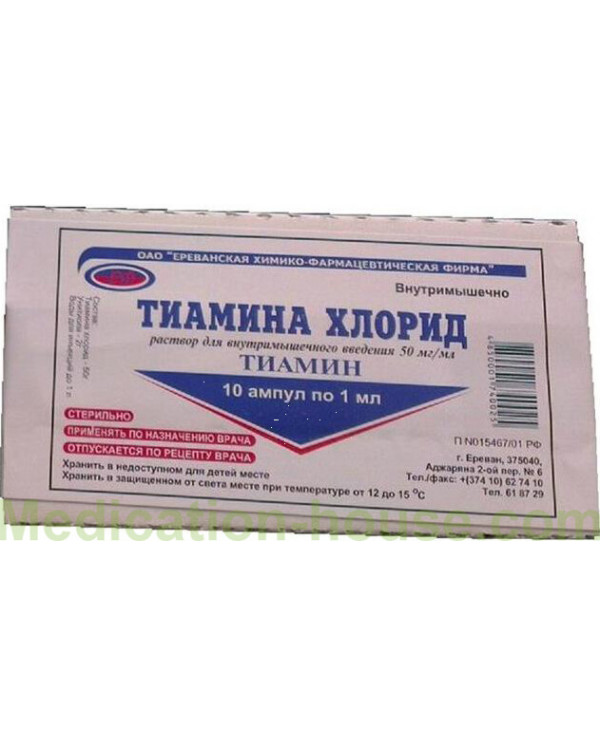Thiamine Chloride instruction
You can buy Thiamine Chloride here
Thiamine chloride injections user manual
Ampoules are injected intramuscularly (deep into the muscle!).
For adults - 0.025-0.05 g (1 ml of 2.5% or 5% solution);
For children - 0.0125 g (0.5 ml of 2.5% solution);
The dose is administered once a day. The entire course of treatment takes 10-30 days.
With Wernicke-Korsakov encephalopathy - 0.05 - 0.1 g (1-2 ml) 2 times a day. Take before clinical improvement. After prolonged use, allergic reactions are possible.
Composition
1 ml of the solution contains the active ingredient thiamine (Vitamin B1) - a colorless, slightly yellowish clear liquid.
Excipients: water for injection, unitiol.
Release form
The drug is available in the form of a ready-made solution for injection of 2.5% and 5%.
Packed in ampoules of 1 ml. 10 ampoules in a carton.
pharmachologic effect
Co-fermentation of the most important enzymes is impossible without this drug. With their help, the carbohydrate metabolism is catalyzed. The vitamin product has a positive effect on the nervous system, reduces excitation by acting on the area of neuromuscular synapses. Responsible for protecting cell membranes, which are oxidized by oxidative products.
Pharmacodynamics and pharmacokinetics
Absorption is a high absorption rate throughout the small intestine. Digestive enzymes are preliminarily released before drug absorption. The concentration of the drug product in the blood is low.
Distribution - free thiamine is released in plasma, and phosphorus esters in white blood cells and red blood cells. Half of the substance settles in the muscle tissue and only 40% on the internal organs.
Metabolism - The phosphorylation reaction occurs in the liver. Perhaps this is due to coenzyme activity. The greatest amount of the drug accumulates in the internal organs, as well as in the brain.
It is excreted passing through the kidneys and intestines.
Indications for use
Assign with:
Vitamin B1 deficiency;
Neuralgia, radiculitis, neuritis, peripheral paralysis;
Gastric and duodenal ulcer;
Liver problems;
Encephalopathy of Wernicke-Korsakov.
Myocardial dystrophy;
Pyoderma;
Eczema
Psoriasis
Contraindications
High sensitivity to Vitamin B1;
Allergic manifestations;
Idiosyncrasy;
In the climatic and pre-climatic periods of the weaker sex.
Use with caution:
Increased nervousness;
Peptic ulcer of the duodenum.
Side effects
Thiamine chloride may cause allergic reactions:
Itching
Hives;
Complicated breathing and swallowing;
Quincke's edema.
In rare cases:
Tachycardia;
Sweating
Collapse;
Angioedema;
Anaphylactic shock is very rare.
Side effects of the drug also include:
Intestinal hemorrhage;
Damage to the optic nerve;
Symptoms of bronchial asthma;
Jumps in blood pressure;
Cardiac arrhythmias;
Failure of the nervous system.
special instructions
Not recommended for use with:
Other vitamins, for example: B12 and B6
Combine with solutions of the sulfate group. Such actions will lead to the complete disintegration of the drug.
Thiamine chloride in ampoules is actively used for hair, in its pure form it is not recommended to apply it to hair. Allergic effects may occur. The drug must be added to masks, hair balms, etc.
To avoid a decrease in the level of vitamin B1 in the body, it is worth revising your daily diet. The most useful component is found in fatty meat, oatmeal, buckwheat, peas and nuts. Do not forget about wholemeal flour, rice bran, green vegetables.
Interaction
The simultaneous use of thiamine chloride with other medicinal components leads to the following consequences:
Pyridoxine complicates the absorption of the drug, and cyanocobalamin, on the contrary, enhances its effect.
The drug weakens the effect on the body of depolarizing muscle relaxants
Long-term treatment with phenytoin, phenobarbital, and carbamazepine can cause thiamine deficiency.
The use of caffeine, as well as substances that contain sulfur or estrogen, increase the need for vitamin B1.
The drug should not be taken in conjunction with analogues that contain sulfites, penicillin-based drugs, as well as nicotinic acid. Under their influence, the destruction of thiamine occurs.
Overdose
It leads to the fact that side expressions are amplified. Long-term use in large quantities will lead to the appearance of the first signs of hypercorticism, namely:
Tremor;
Excitation;
Headache;
Increased heart rate;
Insomnia.
Treatment depends on the symptoms that appear. Refusal to use the drug leads the body to normal.
Storage conditions
Proper storage of Thiamine Chloride will require a cool, dark place in which there is no access for children.
Shelf life - 3 years from the date of manufacture.
Terms of sell
A prescription is not required to buy Thiamine Chloride.

